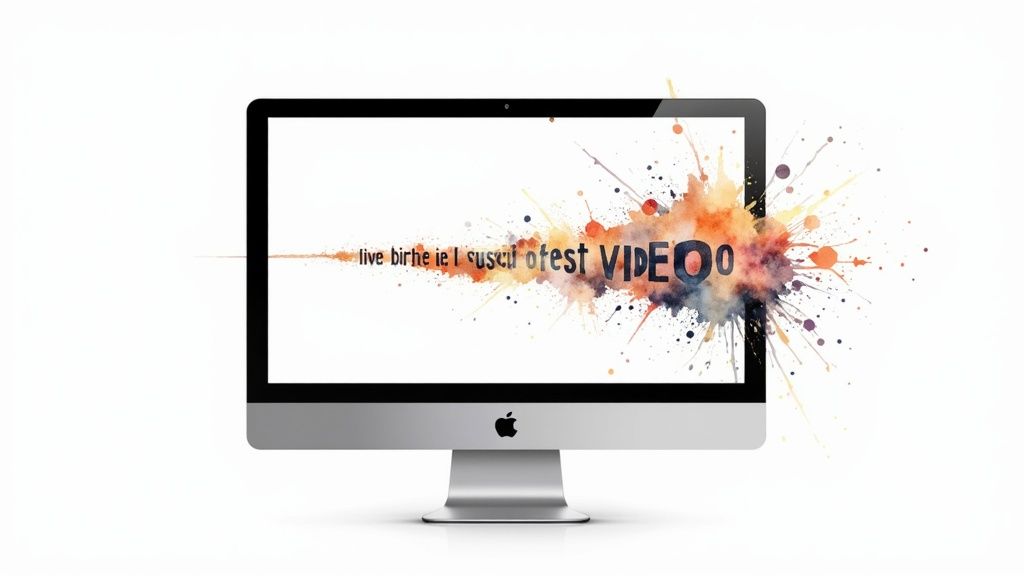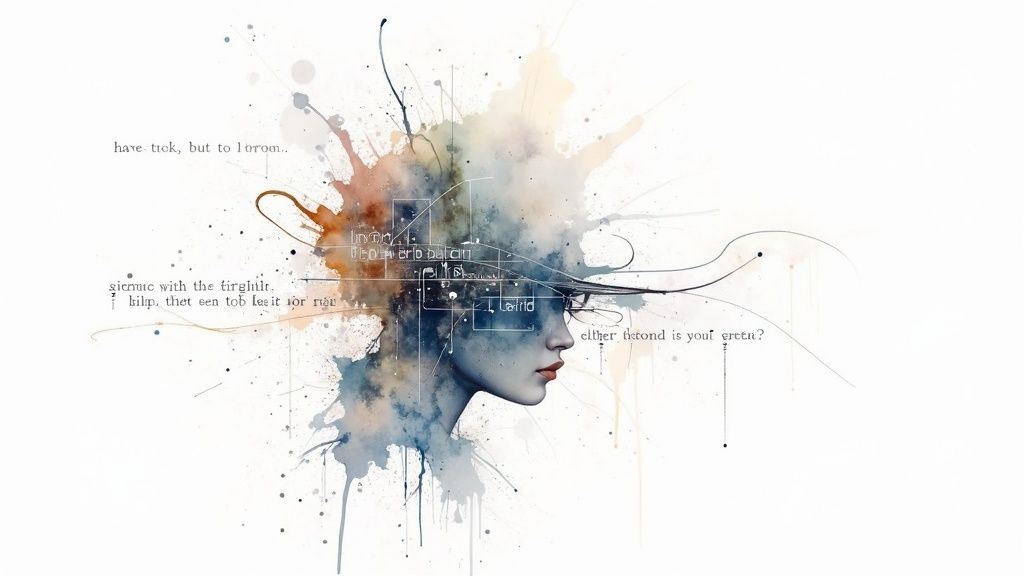The Science Behind Text to Video AI

Text to video AI represents a significant advancement in content creation. This technology allows anyone to transform written content into engaging video narratives. But how does this process work? The magic lies in the combination of Natural Language Processing (NLP) and deep learning models.
NLP, a branch of artificial intelligence (AI), focuses on enabling computers to understand human language. This allows the AI to analyze text, identify key concepts, and extract meaning. For example, if the text describes a "sunset over a tranquil beach," the NLP model recognizes these elements and their relationship. This understanding is crucial for the next stage.
This interpretation then feeds into deep learning models, like diffusion models and Generative Adversarial Networks (GANs). These models are trained on large datasets of images and videos. They learn the patterns and connections between visual elements. Using the NLP model’s output, the deep learning models construct the video. They select visuals, animate scenes, and even generate characters and objects that match the text.
The market for text to video AI is expanding rapidly, reflecting the increasing need for efficient video creation. The global market was valued at USD 122.5 million in 2022. It is projected to grow at a CAGR of 35% from 2023 to 2032. Businesses and institutions are increasingly adopting video content for marketing, driving this growth. Find more detailed statistics here
Understanding Key Components
Several key components contribute to the effectiveness of this technology:
-
Text Encoding: This process converts text into a numerical format that deep learning models understand. It's like translating text into the AI's language.
-
Visual Generation: Deep learning models then use this encoded information to create the corresponding visuals. They synthesize images, create animations, and add special effects.
-
Sequencing and Coherence: The AI arranges the visuals in a logical sequence to ensure a smooth flow. This maintains consistency in characters, backgrounds, and the overall narrative.
Text to video AI has limitations. Current systems sometimes struggle with complex scenes, subtle emotions, and abstract ideas. Generating high-quality videos requires substantial processing power. Despite these challenges, the technology is rapidly evolving. It promises even more realistic and advanced video creation in the future. This offers new possibilities for storytelling, marketing, and communication.
Battle-Tested Text to Video AI Platforms Compared

Not all text to video AI platforms are created equal. Some shine at producing realistic visuals, while others focus on user-friendliness or offer a wide range of customization options. This means finding the right platform hinges on your specific needs and objectives.
This section compares some of the leading text to video AI platforms on the market. It offers a detailed examination of their strengths and weaknesses to empower you to make the best choice.
Key Features and Capabilities
Text to video AI platforms offer a spectrum of features, from simple text-to-animation conversion to sophisticated video editing tools. Some platforms allow you to submit a script and automatically produce a video, complete with visuals, music, and voiceover. Others provide more granular control, enabling you to fine-tune every detail, from individual scenes to character animations.
Let's take a closer look at some core features:
-
Automated Video Generation: Submit your text and let the AI do the heavy lifting. This feature is perfect for quickly creating explainer videos or content for social media.
-
Customization Options: Tailor the visuals, music, voiceovers, and other elements to align with your brand or creative vision. Some platforms offer extensive control, while others are limited to basic template adjustments.
-
Templates and Stock Assets: Access pre-built templates and libraries of stock images, videos, and music to accelerate the creation process. This is a major advantage for users who lack advanced design experience.
-
AI-Powered Editing Tools: Use AI to refine videos with features like automated editing, scene generation, and text-based editing prompts. This can dramatically streamline post-production.
-
Integration with Other Tools: Seamlessly connect with other platforms, such as social media management tools or video editing software.
To help you choose the best fit, we've compiled a comparison table outlining the key features, pricing, ease of use, and output quality of several top platforms.
Platform Comparison Table
Making an informed decision requires a clear understanding of each platform’s strengths and limitations. The table below provides a direct comparison across key criteria.
| Platform | Key Features | Pricing | Ease of Use | Output Quality | Best For |
|---|---|---|---|---|---|
| Pictory AI | Automated video generation, script to video, article to video | Tiered plans starting at $19/month | High | Good | Content creators, marketers, social media managers |
| Synthesia | AI avatars, realistic voiceovers, screen recordings, templates | Tiered plans starting at $30/month | High | Excellent | Corporate training, marketing videos, explainer videos |
| Steve.AI | Animated videos, character customization, wide range of templates | Tiered plans starting at $20/month | Medium | Good | Educators, animators, small businesses |
| InVideo | Video editing, templates, stock media library, collaboration tools | Tiered plans starting at $15/month | Medium | Good | Businesses, marketers, agencies |
| Designs.ai | Automated video generation, templates, text effects, music library | Tiered plans starting at $29/month | High | Good | Social media marketers, small businesses |
This table offers a snapshot of each platform’s strengths and target audience. For a deeper dive into selecting the perfect tool, check out this helpful resource: How to Master Text to Video AI for Stunning Videos.
Choosing the Right Platform
The best platform for you ultimately depends on your specific needs. Consider factors such as your technical skills, budget, and the types of videos you aim to create. If you’re new to this technology, prioritize user-friendly interfaces and pre-designed templates. If you need maximum creative freedom, opt for a platform with advanced features, even if it has a steeper learning curve. Always remember to factor in the quality of the AI-generated output, as some platforms deliver more realistic and polished results than others. Choosing wisely will ensure you maximize the potential of this exciting technology.
How Text to Video AI Is Transforming Content Creation

Text to video AI is dramatically changing the landscape of content creation. It's not just a new technology; it’s a fundamental shift in how creative teams develop content, allowing them to produce high-quality videos more efficiently. Marketing teams, for instance, can now create videos in hours, shrinking production timelines that once stretched for weeks.
This boost in efficiency isn't a trade-off for quality. Many creators are seeing improvements in both output and audience engagement. This rapid turnaround allows creators to respond to trending topics and audience feedback almost instantly.
Empowering Small Businesses and Leveling the Playing Field
Text to video AI is democratizing video creation, a significant impact for smaller businesses. These businesses, often lacking dedicated video production resources, now have the power to create professional-quality visual content. This enables them to compete more effectively with larger organizations.
Imagine a local bakery showcasing its newest pastries with polished videos, or a startup explaining its service through engaging animations. Accessible text to video AI platforms like Aeon make this possible. This change is removing traditional barriers, leading to a more diverse and competitive media environment.
The benefits go beyond creation. Text to video AI also impacts the entire content development process. Tasks that once required significant time, like storyboarding and animation, are now drastically faster. This shift allows creative teams to concentrate on higher-level strategy and storytelling.
Creators can rapidly iterate on ideas, experiment with different visual approaches, and tailor content to specific audiences. These enhancements result in more targeted and successful video campaigns.
The future of text to video AI appears promising. The market is projected for substantial growth, with estimates reaching nearly USD 2,479.7 million by 2032, growing at a CAGR of 26.2%. Another forecast suggests it could reach USD 1,453.16 million by 2030, with a CAGR of 33.4%. The increasing need for video across various sectors, including education, healthcare, and business, is driving this expansion. Find more detailed statistics here: https://market.us/report/text-to-video-ai-market/
Combining AI with Human Creativity for Unique Results
While AI improves efficiency, human creativity remains crucial. Savvy creators are integrating AI-generated content with their artistic vision. They are using text to video AI to enhance, not replace, their creative process. This approach enables the creation of unique visual styles that truly stand out in the digital world.
Creators might use AI to generate the base animation, then add personalized details, refine elements, and weave in their brand's unique identity. This collaboration between human creativity and artificial intelligence is unlocking new opportunities for visual storytelling.
This blend of AI and human input leads to measurable outcomes. Organizations are seeing cost reductions, higher conversion rates, and increased team efficiency. By automating repetitive tasks, text to video AI empowers teams to focus on strategy, creativity, and achieving content goals. This evolution in content creation emphasizes the importance of adapting to new technology while retaining the human touch that resonates with audiences.
Innovative Text to Video AI Applications Across Industries

Text to video AI is changing the way industries create video content. Its applications go beyond marketing, offering solutions to diverse challenges. This exploration reveals how educators, healthcare providers, real estate professionals, and nonprofits leverage this technology for impactful results.
Education: Bringing Abstract Concepts to Life
Text to video AI empowers educators to transform abstract ideas into understandable visuals. This is particularly helpful in science and mathematics, where visualization improves comprehension. Imagine a complex physics equation becoming an animated demonstration. This simplification makes learning more accessible and engaging, potentially boosting knowledge retention.
Healthcare: Personalized Patient Education
Healthcare providers can use text to video AI for personalized patient materials. Instead of standard pamphlets, videos explaining procedures, treatments, or medication instructions can be created. This tailored approach improves patient compliance and empowers them to actively participate in their care. A video explaining post-surgery care, for instance, can reduce anxiety and improve recovery.
Real Estate: Virtual Tours at Scale
Real estate professionals now generate virtual property tours quickly using text to video AI. Potential buyers can explore properties remotely, saving time and resources. Creating these tours from text descriptions increases efficiency and expands reach for agents. This allows showcasing more properties to a wider audience.
Nonprofits: Storytelling That Drives Impact
Nonprofits can leverage text to video AI to create compelling stories that resonate with donors, even on limited budgets. This technology allows them to produce high-quality videos without the typical high costs. Transforming written narratives into emotional videos increases engagement and boosts fundraising efforts, crucial for achieving greater impact.
Learn more in our article about how to transform your stories with text to video AI.
Implementation and Outcomes
Implementing text to video AI across these sectors offers significant benefits, from increased engagement to cost savings and improved communication. Organizations experience reduced production time, sometimes from weeks to hours. Furthermore, increased audience engagement and improved information retention are commonly observed. The table below provides a detailed overview of these applications.
To better understand the industry-specific implementations, benefits, and challenges of this technology, the following table offers a detailed overview.
Text to Video AI Applications by Industry
| Industry | Primary Use Cases | Key Benefits | Implementation Challenges | Success Metrics |
|---|---|---|---|---|
| Education | Visualizing complex concepts, creating engaging lessons, gamified learning modules | Improved student comprehension, increased engagement, improved accessibility for diverse learners | Ensuring accuracy of visual representations, integrating with existing learning management systems | Increased test scores, higher student engagement rates, improved student feedback |
| Healthcare | Personalized patient education, explaining procedures, medication instructions, post-discharge care guidance | Improved patient compliance, better communication, reduced anxiety, empowered patients | Maintaining patient privacy and data security, ensuring accessibility for patients with varying levels of digital literacy | Improved patient satisfaction, reduced readmission rates, increased adherence to treatment plans |
| Real Estate | Virtual property tours, property marketing, agent introductions, neighborhood overviews | Increased efficiency, expanded reach, cost savings, enhanced property showcasing | Ensuring accurate and up-to-date property information, integrating with existing real estate platforms | Increased lead generation, faster sales cycles, higher customer satisfaction |
| Nonprofits | Compelling storytelling, fundraising campaigns, volunteer recruitment, awareness campaigns | Increased donor engagement, greater impact, broader reach, cost-effective video production | Measuring impact and ROI, securing funding for technology adoption | Increased donations, higher volunteer sign-up rates, greater public awareness |
The data presented in this table reveals the diverse ways text to video AI is being implemented and the positive outcomes it's driving. As the technology continues to evolve, we can expect even greater advancements in communication and content creation.
Mastering Text to Video AI Prompts for Professional Results
The key to unlocking high-quality video content with text-to-video AI lies in the art of crafting effective prompts. Think of a prompt as a set of instructions for the AI. A well-crafted prompt guides the AI to generate a video that perfectly captures your vision. In contrast, a poorly written prompt can result in a video that misses the mark. Through analysis of numerous prompts, we've identified key factors that contribute to their success.
The Power of Precise Language
The words you choose have a significant impact on the final video output. For instance, instead of using a generic phrase like "a car on a street," try something more descriptive like "a vintage red convertible speeding down a bustling city street at sunset." The added detail helps the AI paint a more vibrant and engaging picture. Mastering prompt writing involves understanding the specific language that resonates with AI video generation tools.
Understanding how AI interprets language is also important. While AI is constantly evolving, it still doesn't grasp nuances the same way humans do. You might be interested in: How to make text videos - the ultimate guide to AI powered video creation. Therefore, clear and concise language is crucial. Think of it like giving directions – the more specific you are, the better the outcome.
Common Prompt Mistakes and How to Avoid Them
Many creators fall into the trap of using vague or generic prompts. This often leads to videos that lack visual appeal and fail to convey the intended message. Another common mistake is overloading the prompt with too much information. This can overwhelm the AI, just like a cluttered room overwhelms a person.
Here's a table outlining common prompt mistakes and their solutions:
| Mistake | Example | Solution |
|---|---|---|
| Vague Language | "A beautiful landscape" | "A sun-drenched meadow filled with wildflowers, backed by snow-capped mountains" |
| Too Much Information | "A futuristic city with flying cars, robots, aliens, and laser beams in a cyberpunk style with a retro 80s vibe" | "A futuristic cyberpunk city with flying cars and neon lights" |
| Lack of Context | "A man running" | "A man sprinting through a forest, pursued by a shadowy figure" |
By avoiding these pitfalls and using clear, concise, and descriptive language, you can dramatically improve the quality of your AI-generated videos.
Building Scene Sequences and Maintaining Visual Consistency
Creating longer videos requires careful consideration of how individual scenes connect. Scene sequencing is essential for a smooth narrative flow and visual consistency. Just like a film director plans shots, you must structure your prompts to create a cohesive video.
One effective strategy is using keywords to link related scenes. If a scene includes a "blue orb," ensure it appears in subsequent scenes to maintain continuity. This helps viewers follow the narrative and creates a sense of visual harmony. Similarly, consider character actions and emotions. Provide specific details on how characters should move and react within each scene.
By mastering these techniques, you can use text-to-video AI to create professional-quality videos that engage your audience and effectively communicate your message.
What's Next for Text to Video AI Technology
Text to video AI is changing rapidly, constantly expanding the possibilities of video creation. This leads us to a critical question: what does the future hold for this technology, and how can content creators prepare? Insights from AI researchers and product developers suggest exciting new capabilities are on the horizon, ready to reshape video creation as we know it.
Advancements on the Horizon
Several key advancements are poised to revolutionize text to video AI:
-
Enhanced Visual Quality: We can anticipate significant improvements in resolution, detail, and realism. Imagine AI generating videos that are virtually indistinguishable from professionally shot footage. This will unlock opportunities for high-quality content across various platforms.
-
Improved Character Realism: The current challenges in creating realistic human characters in AI-generated videos are being addressed. Future versions of this technology will likely include more natural movements, nuanced expressions, and believable interactions.
-
Greater Creative Control: The ability to fine-tune the details within AI-generated videos is growing. Creators will gain more control over elements such as camera angles, lighting, and pacing, allowing them to achieve specific artistic goals.
These advancements will not only improve existing applications but also open up entirely new creative possibilities. Content creators who embrace these changes will have a significant advantage.
Overcoming Current Limitations
While text to video AI is already powerful, challenges remain. Some, like enhancing the rendering of complex scenes and creating smoother transitions, are likely to be solved in the near future. Others, like perfectly capturing emotional nuances in characters or replicating the unpredictable creativity of human artists, will likely remain long-term objectives.
However, ongoing research and development are paving the way for solutions. For example, multimodal AI systems, which combine text, images, voice, and even motion data as inputs, are emerging. This integration of multiple data types promises richer and more engaging video content.
Ethical Considerations and Responsible Creation
As text to video AI becomes increasingly sophisticated, ethical considerations are paramount. The potential for misuse, especially with deepfakes and other forms of synthetic media, demands careful attention. Copyright concerns and emerging regulations surrounding AI-generated content must also be addressed.
Responsible creators should understand these issues and adopt ethical best practices. This includes acknowledging the technology's limitations, verifying information presented in AI-generated videos, and respecting intellectual property rights.
Building Adaptable Workflows
The rapid evolution of text to video AI requires flexible workflows. Creators should prioritize continuous learning and experimentation. Staying informed about new platforms, features, and best practices is crucial for harnessing the full potential of this technology.
By embracing change and adapting their workflows, creators can leverage the power of text to video AI. Building processes that incorporate AI tools while retaining the human element of creativity and critical thinking will be key to future success in video content creation.
Ready to explore the possibilities of text to video AI? Visit Aeon and transform your content creation process today!